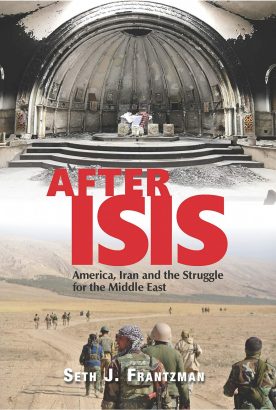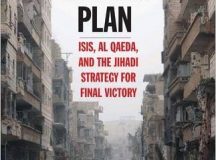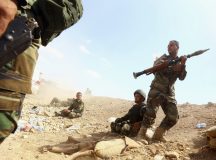We’ve encountered the toponyms repeatedly in the headlines: Sinjar. Raqqa. Kirkuk. Kobane. Baghuz.
But we’ve done so from the comfort and safety of our vantage points far from the front lines. Veteran Jerusalem Post reporter Seth Frantzman, on the other hand, determined he would bear witness to the evidence of ISIS’ brutality and has now fulfilled that aim with his new book. After ISIS is not about ISIS per se, which will come as a relief to those with little interest in rehashing the notorious terrorist group’s well-publicised savageries. Instead, it is a journalist’s testament, documenting firsthand the aftermath of the group also known as Daesh and the devastating effects of its short-lived quasi-Caliphate. Based on six trips to Iraq, two to Turkey and Jordan, and visits to Egypt, Senegal, the UAE, and Europe over the course of four years (as well as copious interviews), the account treats of the devastation endured by persecuted minorities including Kurds, Yazidis, Christians, and Yarsanis (Kaka’i), and the destruction visited on the desert landscapes of Syria and Iraq.
The author limns the wake of the Yazidi genocide and spends a good deal of time among the Peshmerga and other Kurds, belying the adage that ‘Kurds have no friends but the mountains.’
Frantzman surveys the battlegrounds and investigates the war’s impacts on locals and their homes. He reflects on the counterintuitive modus operandi of ISIS, which ‘preyed on the middle class, more than on the illiterate poor and traditional.’ And its methods proved effective, for ‘at its height ISIS had access to some fifty thousand fighters, many of them foreign volunteers who traveled through Turkey from points in Europe, Chechnya, Tunisia and elsewhere.’ The group’s ideological magnetism stirred dark impulses the world over, attracting members in droves to wage jihad under the infamous black banner: ‘The migration to join ISIS was unprecedented. It far outpaced the number of foreigners who had volunteered to fight against the Soviets in Afghanistan in the 1980s, the core group that helped lead to al Qaeda, and it is far more than those who went to fight in Chechnya and the Balkans in the 1980s. One of the major differences with ISIS is that while the 1980s and 1990s saw transitional jihadism, it often involved Arabs radicalised at home going to fight as foreign fighters. With ISIS, the process was the opposite: it was extremists from all over the world coming to the Middle East.’
Frantzman soon encounters the vestiges of war crimes and crimes against humanity. He attests to the mass graves in sinkholes and elsewhere: ‘Two hundred [and] two mass graves would eventually be found, with an estimated twelve thousand victims in them. Only 1,258 bodies had been identified by the Iraqi Mass Graves Directorate by the fall of 2018. The UN used terms like “harrowing human loss” to describe what was often a targeted campaign of extermination. The generalising of the crimes, to describe the victims as “women, children, elderly people,” made it seem that many groups were equally targeted. But the reality was that the graves often contained specific groups, such as foreign workers or former Iraqi security forces members.’
The region’s complexity derives from the contrary, and often contradictory, agendas of its various players and rivalrous sideliners, including Iran, Turkey and the West, as the author underscores: ‘In Iraq, the Kurds resented Baghdad and thought ISIS would rid them of the burden of Iraq. Iran thought ISIS extremism would undermine Sunnis and make the West rely on Iran as a moderate ally. The Syrian regime also saw ISIS having a positive effect, as it attacked the Syrian rebels and weakened the opposition. Ankara blamed Europe as ISIS supporters sought to transit through Turkey. Chechen ISIS members were a serious threat, and Chechnya likely allowed them to leave in the hope they would not come back.’
As the anti-ISIS campaign winds down, Frantzman reflects on the difference between global conflicts today, especially asymmetrical counterterrorism campaigns, in contradistinction to those of yesteryear, lamenting that ‘Wars don’t end the way we’re told they do. There is no Appomattox courthouse, no Treaty of Westphalia, no simple victory. Instead, the enemy melts back into the towns and villages it came from. The allies look askance at those they thought they were fighting alongside. Nobody wins. Victims don’t get justice. Perpetrators get sympathy. Mass graves return to nature, the secrets they hold forgotten. There is no catharsis.’ In lieu of decisive victory, what eventuated in this case is a Shi’ite crescent arcing from Iran to Lebanon: ‘Tehran was a major beneficiary of the chaos left behind by the Sunni extremists.’ One lesson from this war was that ‘you can win the battle, but you might end up leaving the battlefield to adversaries – such as the Syrian regime or Iranian-backed militias in Iraq – when it is all over.’ A stark, sobering thought, though there are other insights to be gleaned from the campaign, more positive and pre-emptive in nature, including that ‘groups like ISIS must not be permitted to gain a foothold and expand. They should be taken seriously, and their pronouncements, such as threats of bringing back slavery and genocide, should be of global concern. A corollary to that is to take seriously growing radicalisation at home and not to expect that foreign movements preaching extremism can be ignored in an era of globalised social media.’
While the book debuted shortly before the US special forces operation to eliminate ISIS leader Abu Bakr al-Baghdadi, Frantzman concedes that the group’s reduction and territorial losses proffer no guarantees for the future: ‘Even in defeat in Iraq and Syria, the tentacles of ISIS still threaten the world.’
After ISIS faithfully depicts a bleak theater of war, with its tableau of human suffering casting grim shadows against an expansive backdrop replete with Humvees, Toyotas, SUVs, IEDs, warplanes, airstrikes, snipers, pockmarked buildings, surrendering jihadists, and jihadi brides naturally claiming to have known nothing. This region, once known as Mitanni (the Land of the Hurrians) and in the Hebrew Bible as Aram-Naharayim/Padan Aram, was inherited chiefly by the Kurds, possibly once known as the Cardochoi or Cyrtii and probably descended from the ancient Medes of Medo-Persian fame. The region is long accustomed to the vagaries of warfare and the frequent rise-and-decline of rulers.
In our own day, the prevailing reality of the Middle East is one of geostrategic maneuvering, a pas de deux between forces progressive and retrogressive, between stabilisation and destabilisation. Frantzman foregrounds the convoluted political situation, which comprises several alliances and coalitions, each multi-faceted and competitive, and which features a slew of acronyms and initialisms (e.g., YPG, KRG, KDP, PUK, PKK, HPE, ISF, AQIM, MUJAO, etc.), for which reason laypersons would have benefitted from a chart in the book’s front matter adumbrating especially the sundry political parties and their affiliated ‘protection units’ (armed wings). One of the book’s assets as a historical account—its thoroughness—inevitably doubles as a narrative liability: casual readers may weary of the play-by-play recapping the comings and goings of diplomatic envoys, the statements of military officials, and the like. Frantzman is at his best when he zooms out from the overcrowded fray to analyse the bigger temporal and spatial picture. He is among the rare breed of journalists in possession of a doctorate and adeptly assesses a complicated context.
With its reportorial account attesting to the past and its closing hypotheses auguring the future, After ISIS frames the ISIS phenomenon and the gross injustices committed against those who survived it and those who succumbed to it. It is a workmanlike testimony and tribute calling attention to terrorism’s victims, and attention must be paid. The book includes 16 pages of black and white photographs, as well as notes.




































